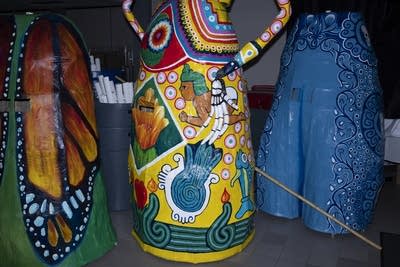Artists' colorful creations ready to lift spirits for Día de Muertos
Supporters hope Sunday festival brings joy to south Minneapolis after tough year

Go Deeper.
Create an account or log in to save stories.
Like this?
Thanks for liking this story! We have added it to a list of your favorite stories.
The conference room buzzed with laughter and talk.
It’s a Thursday night and for several weeks local artists and community members have gathered to prepare for the upcoming Día de Muertos celebration on Lake Street in Minneapolis.
Standing over a 6-1/2-foot orange cross, Flor Soto makes paper cempasuchil flowers.
“I plan to decorate it with a heart in the middle and the rest of it with just flowers. I want the heart to stand out so we are going to put it in the very center,” Soto said.
Turn Up Your Support
MPR News helps you turn down the noise and build shared understanding. Turn up your support for this public resource and keep trusted journalism accessible to all.
Cempasuchil paper flowers, alebrijes and monarch butterflies fill the makeshift artists’ workshop.

The larger alebrijes and Catrinas will be part of the procession from Powderhorn Park to the corner of Lake Street and Chicago Avenue. It begins at noon on Sunday and will be followed by a street festival held in partnership with CLUES, BareBones Theater and Festival de las Calaveras.
The cross was made by students who were as young as 4 to their early 20s. Seeing so many young people taking part in creating the piece and taking part in the preparations for the festival was beautiful, Soto said.
“Our culture is attracting all ages because even children have come to work on the projects and they don’t want to leave,” she said.
The cross contains a hidden, yet very important, element.
“They put what they don’t want on this cross,” said Soto. “Things they want to forget, what hurts them. It’s underneath and can’t be seen. But that’s the idea to try to forget what they want to forget.”
In a nearby room Gustavo Boada is painting the final touches to his alebrije.

An alebrije is an animal that has the features of several animals. Alebrijes are the creation of Mexican artist Pedro Linares. While very ill and unconscious, he dreamt of these strange, colorful creatures that kept shouting the name “alebrijes.”
“This is going to be some mix of an armadillo and turtle. I love to do three legs (on) animals. Yeah, it’s crazy right?,” Boada said.
His three-legged turtle armadillo will be mounted on a bicycle. And the driver will be able to move the animal’s head.
Pablo Helm Hernandez, a freelance artist from Minneapolis, created a blue moose alebrije. But this is no ordinary moose. It has a moose’s body with a cow’s nose, a lemur’s tail and an alligator’s mouth.
The moose, which stands 13 feet at its tallest point, is made from papier-mâché. Helm Hernandez said it took close to 60 hours to create. But it wasn’t a one-person project. He had help from Boada, who has also been a mentor, and from individuals who attended the community workshops.
“It was great. I love working with other people,” Helm Hernandez said. “This is the first time I’ve made anything of this scale with this kind of material.”
Working at a table a few feet away from Boada, Constanza Carballo works on a calavera — or skull. Calaveras play a key role in Day of the Dead celebrations.
The calaveras aren’t meant to be scary, Carballo said.
“We the living, by making these skulls are connecting and keeping our loved ones alive. And also by making these skulls, it’s like we face our own mortality,” she said.
And that’s why Carballo chose to make her calavera using mirrors.
“The spectator, when they come look at it, they can reflect and see their life, but also see their own death per se,” Carballo said.
Aaron Johnson-Ortiz, CLUES director of arts and cultural events, hopes the celebration becomes an annual event.
“We really feel that Lake Street is a cultural corridor for the Latino community in particular. We believe that Day of the Dead is widely misunderstood by the public and so I think that this is the way for us to honor our dead and to really come together as a community,” Johnson-Ortiz said.

The celebration is what the neighborhood needed after all the sadness, Boada said. COVID-19 and the unrest that followed the killing of George Floyd by police hit the Lake Street area especially hard. The festival is a way to show the spirit of the Latino community, Boada said.
The event will even feature a coronavirus piñata made by Soto. And everyone, regardless of age, is welcome to give it a whack.
“That is the intention,” Soto said, “of getting rid of a little bit of the anger they have for this disease that has caused the death of family and relatives, friends.”
Vicki Adame covers Minnesota’s Latino communities for MPR News via Report for America, a national service program that places journalists into local newsrooms to report on undercovered issues and communities.





